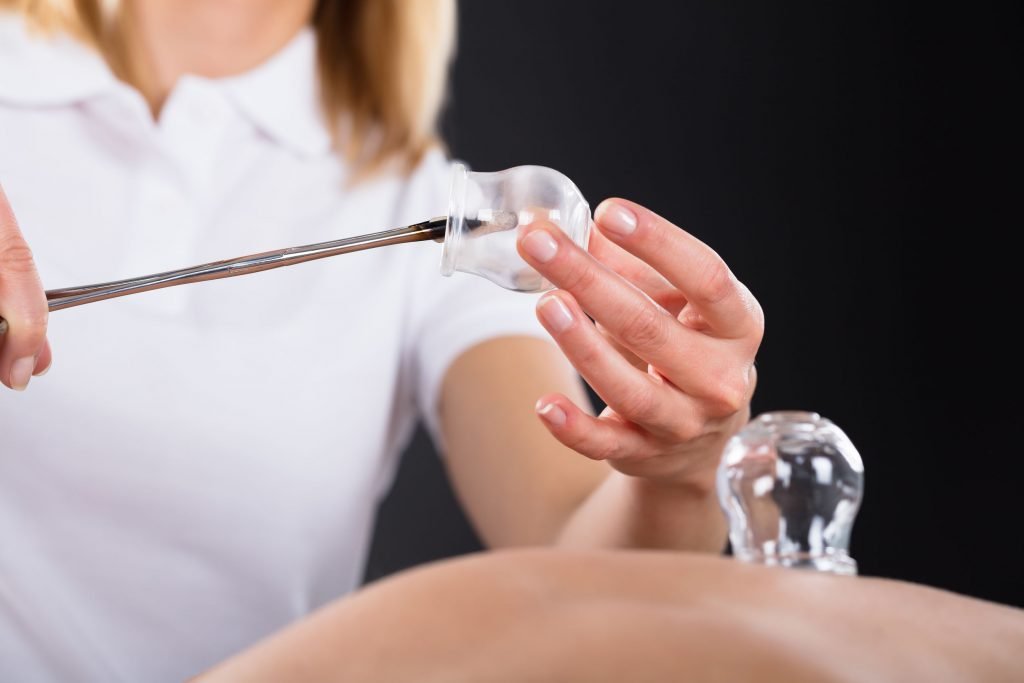Student Scholarship Honorable Mention
Maryellen Tedeschi, ND, BSc (Hons)
Yana Gutmakher
Erin Truscott-Brock, ND
Cellulite is a normal physiologic change in skin texture, colloquially termed “orange peel” dimpling or “cottage cheese” skin for its topographical presentation of dips and valleys. Cellulite can occur in women of all races and is most notably seen in areas of higher fat accumulation, such as the abdomen, thighs, and buttocks. In males, fat is organized and supported by connective tissue that runs in a cross-cross pattern; this minimizes the appearance of cellulite. In females, that connective tissue runs perpendicular to the skin, which can result in a pulling and puckering of the skin.1
Cellulite affects 85-98% of post-pubertal females. It develops as a result of the following proposed factors/mechanisms: sexually dimorphic skin architecture; altered connective tissue septae, resulting in micro-nodules and adhesions that trap adipose tissue; vascular changes of the micro-capillary network in the fascia; and inflammation that causes metabolic changes resulting in hyperplasia and hypertrophy of the reticular network. The appearance of cellulite is exacerbated by increased skin flaccidity (where the skin is permanently distended and loose); greater thickness of the subcutaneous fat deposits; and/or venous or lymphatic insufficiency.2
Cupping, which is used for a variety of therapeutic purposes, is a traditional therapy incorporating the use of special plastic cups to create suction on the skin. This case study explores 6 weeks of heated cupping therapy to improve the look of cellulite on the legs and gluteal region of a 32-year-old woman.
Case Presentation
YG is a 32-year-old female presenting with cellulite (beyond bound) bilaterally on the legs. Cellulite was most visible along the posterior gluteal fold. During the first visit a full history was taken, and a physical exam was conducted that included weight and measurements and photos of both legs (posterior, anterior, and lateral sides). (See Table 1 for pre-treatment photos, taken on 9/21/17.) Outcome measures in this study were patient observations, photo comparison, weight, and measurements.
Measurements at Week 1 (prior to treatment):
- Circumference of right thigh = 71.5 cm
- Circumference of left thigh = 71.5 cm
- Circumference of widest part of buttocks = 160.5 cm
- Circumference of widest part of hips = 118 cm
- Weight = 194 lb
Treatment
Patient came in weekly for a total of 6 cupping treatments. A plastic suction cupping set was used, with medium-sized cups. For the duration of the 6-week treatment period, the patient maintained our recommended diet and exercise practices.
Areas treated included bilateral posterior thighs (gluteal fold to above the popliteal fossa, and avoiding the iliotibial [IT] band); gluteal muscles just below the sacrum; and bilateral anterior thighs including the IT band (greater trochanter to above the patella).
The treatment protocol, which was conducted once weekly from Week 1 to Week 6, involved the following steps:
- Surface area to be treated was warmed with a hydrocollator heat pack for 5 minutes
- Liquid coconut oil (1-2 tsp) was applied to the warmed area
- One medium-sized cup was applied to the skin and pumped 1 time with a hand pump, until 0.5-1.0 cm of skin was inside the cup (to patient’s tolerance)
- Brisk light circles were applied to the area to further warm and prep the skin
- The cup was then moved in the same direction as muscle fibers around the entire area for 5 minutes
- The cup was pumped 1-2 more times, to patient tolerance, once the area was thoroughly warmed up
Table 1. Before & After Photos
| Location | 9/21/17 | 11/2/17 |
| Anterior | 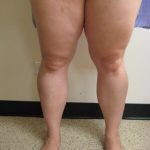 |
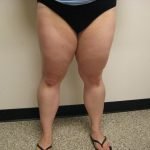 |
| Posterior | 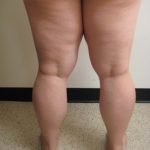 |
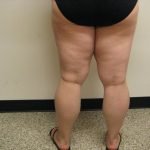 |
| Right Leg | 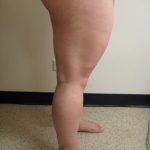 |
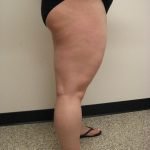
|
| Left Leg | 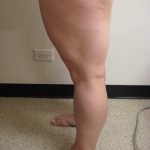 |
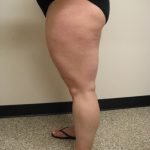
|
Measurements at Week 7 (after 6 weeks of treatment):
See Table 1 for post-treatment photos, taken on 11/2/17.
- Circumference of right thigh = 69 cm
- Circumference of left thigh = 69 cm
- Circumference of widest part of buttocks = 157.5 cm
- Circumference of widest part of hips = 118 cm
- Weight = 198 lb
Discussion
From Week 1 to Week 6 of treatment, there was a noticeable improvement in YG’s pain tolerance during the treatment protocol. During Weeks 1 and 2, suction was only tolerated to 0.5 cm, whereas during Weeks 4 and 5 there was an increase in suction to 1.5 cm, and even 2.0 cm in the gluteal area.
Difference in measurements taken from Week 1 vs Week 7 were -2.5 cm in the circumference of both thighs, and -3 cm in the circumference of the widest part of the buttocks. Weight increased 4 lb from Week 1 to Week 7.
Although there are no obvious differences between the photos taken from Week 1 and Week 7, patient observations included noticeably smoother skin and increased flexibility of the lower extremities. The patient had experienced left lower leg tingling for 2 years prior to the intervention and reported that the tingling lessened considerably during the treatment period. Due to the overall satisfaction and improved tolerance that the patient experienced during this 6-week protocol, we will be continuing treatment and tracking our progress for the next 6 weeks.
References:
- Avram MM. Cellulite: a review of its physiology and treatment. J Cosmet Laser Ther. 2004;6(4):181-185.
- Goldman MP, Hexsel D, eds.Cellulite: Pathophysiology and Treatment, 2nd Edition. London, England: Informa Healthcare; 2010:30-45.
 Maryellen Tedeschi, ND, BSc (Hons), is a new graduate from the Doctor of Naturopathic Medicine program at CCNM in Toronto. She is a naturopathic intern at the Robert Schad Naturopathic Clinic and Sherbourne Health Centre. Maryellen was first introduced to naturopathic medicine during her undergraduate studies at McMaster University in Hamilton, Ontario. After completing a placement in an integrative medical clinic and shadowing a naturopathic doctor, Maryellen knew that pursuing this career would allow her to follow her passion for providing holistic and individualized health care to others. Maryellen looks forward to providing patient-centered care as a naturopathic doctor in Hamilton in the near future.
Maryellen Tedeschi, ND, BSc (Hons), is a new graduate from the Doctor of Naturopathic Medicine program at CCNM in Toronto. She is a naturopathic intern at the Robert Schad Naturopathic Clinic and Sherbourne Health Centre. Maryellen was first introduced to naturopathic medicine during her undergraduate studies at McMaster University in Hamilton, Ontario. After completing a placement in an integrative medical clinic and shadowing a naturopathic doctor, Maryellen knew that pursuing this career would allow her to follow her passion for providing holistic and individualized health care to others. Maryellen looks forward to providing patient-centered care as a naturopathic doctor in Hamilton in the near future.
***
 Yana Gutmakher graduated from Michigan State University with a BA in Communication and Public Relations. She will graduate from the Canadian College of Naturopathic Medicine (CCNM) in 2019 with her Doctorate of Naturopathy. Following graduation, Yana hopes to practice in Michigan, with a special focus on connective tissue disease and women’s health issues.
Yana Gutmakher graduated from Michigan State University with a BA in Communication and Public Relations. She will graduate from the Canadian College of Naturopathic Medicine (CCNM) in 2019 with her Doctorate of Naturopathy. Following graduation, Yana hopes to practice in Michigan, with a special focus on connective tissue disease and women’s health issues.
***
 Erin Truscott-Brock, ND, completed her honours Bachelor of Science from the University of Toronto and continued on to the Canadian College of Naturopathic Medicine (CCNM), graduating in 2000. She has been in private practice ever since, working with patients of all ages and all concerns. Dr Truscott-Brock has been a clinic faculty member at CCNM since 2004, supporting 4th-year interns in their clinical practice. She is also active in NPLEX and is a co-chair for clinical writing. Dr Truscott-Brock is particularly interested in autoimmune diseases, neurology and head injury, gastroenterology, and endocrinology.
Erin Truscott-Brock, ND, completed her honours Bachelor of Science from the University of Toronto and continued on to the Canadian College of Naturopathic Medicine (CCNM), graduating in 2000. She has been in private practice ever since, working with patients of all ages and all concerns. Dr Truscott-Brock has been a clinic faculty member at CCNM since 2004, supporting 4th-year interns in their clinical practice. She is also active in NPLEX and is a co-chair for clinical writing. Dr Truscott-Brock is particularly interested in autoimmune diseases, neurology and head injury, gastroenterology, and endocrinology.

